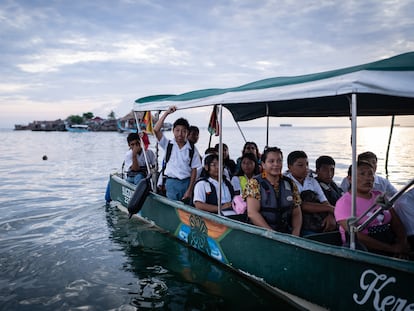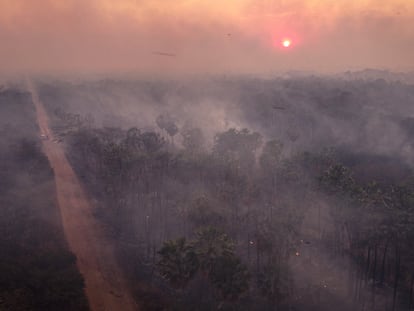The expedition that searched for the tallest tree in the Amazon and found a sanctuary of giant specimens
A forestry engineer tells of researchers’ foray into the jungle to inventory the flora and fauna living near the 70-meter tall giants
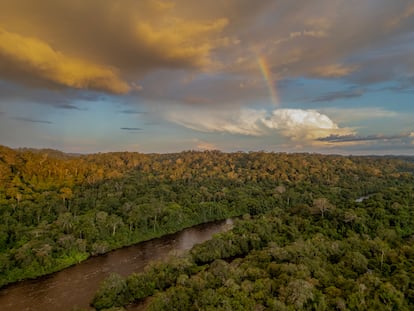

Entering the Paru rainforest reserve, one of the most inaccessible and best preserved regions of the Amazon Rainforest, is truly special even for a seasoned veteran of the Brazilian jungles: “When I got there, my eyes shone like a child’s when they saw a sweet. I know other ecosystems, but this one is practically intact,” recalls forestry engineer Lucyana Santos in a video interview. Santos participated in a two-week scientific expedition last May that aimed to reach the tallest tree in the Amazon, an angelim vermelho (Dinizia excelsa) measuring 88.5 meters (twice the height of Rio de Janeiro’s Cristo Redentor, a 30-story tower), which was discovered five years ago in the west of the Brazilian state of Pará.
“We were unable to reach it because a waterfall prevented us from doing so,” says the engineer, who works at the Institute for Forest and Biodiversity Development of the State of Pará (Ideflor). Doing research in the largest tropical forest on the planet comes with these sorts of difficulties: in addition to the enormous physical effort required, researchers are also at the mercy of a thousand unforeseen events. Santos’ team waited three days for the water to recede in order to cross the waterfall, but it was of no use.
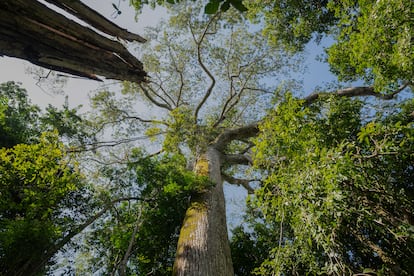
Although they never reached their original destination (a previous expedition managed to reach the 88.5-meter angelim vermelho), along the way they discovered a new sanctuary of giant trees. Santos and a handful of other scientists from the expedition collected samples in six plots that were turned into jungle laboratories, each one measuring 2,500 square meters. There, she says, they took soil samples, made an inventory of the flora and fauna, including fish from the Jaru River and its tributaries. They sighted birds and tracks of large mammals such as jaguars, without crossing paths with any. The goal was to expand research of this reserve in order to increase its legal protection and ensure that it is preserved in the best conditions. Inspecting the crown of the giant trees has been left for another occasion.
The Paru reserve, which covers an area of 14,000 square miles (slightly less than the size of Denmark), is located 300 miles west of the city of Belém, which is preparing to fulfil a long-held dream of Brazilian President Luiz Inácio Lula da Silva: bringing the best climate change researchers to the Amazon. Next year, Belém will host COP30, the U.N. climate summit.
Santos explains that during the recent expedition they discovered that the giant trees are more numerous and more dispersed than previously thought. It’s still not known why this corner of Pará is home to trees that are twice the height of the forest, the tallest in the Amazon. “We don’t know why or why here. Whether it is because there is a microclimate with specific conditions of temperature and wind, or whether it is because of the soil, or the proximity to water…” The age of the trees is also a mystery: “We believe they are between 400 and 600 years old, but that is also an assumption.”
In this area, 38 giant trees have been identified, including two that are over 80 meters tall. What is known is that these specimens play an essential role in maintaining biodiversity and ecological balance, as well as in climate regulation thanks to their extraordinary capacity to store carbon (measured by laser scanning from the International Space Station). But they are also the historical memory of the forest, a door to the past.
In exchange for reaching a place where few humans have ever set foot, these scientists must be prepared to live and work in arduous conditions. “The hardest part is the day-to-day work, the effort of collecting information and samples on a long journey, with high temperatures and high humidity,” explains Santos. To reach the spot, the scientists took a plane, then a car, then a boat… and then began the climb up the Jaru River towards the reserve of the giant trees.
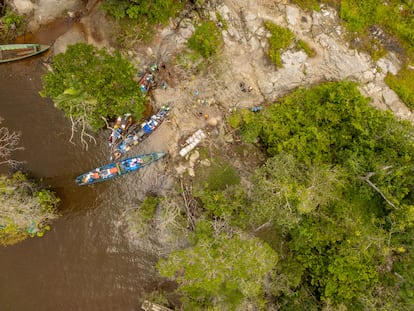
They were joined by local guides who know how to navigate the rivers and the jungle. And by two press advisers. And, of course, they were loaded with scientific material, water, food, medicines, GPS, binoculars, ice, chlorine to make the water drinkable when the bottled water runs out. They had to be prepared for long hikes, under the sun and the rain, through very dense, uneven vegetation. The climate often changes, and suddenly. “You put on your raincoat, take it off, put it back on…,” says Santos. The researchers slept in hammocks, protected by mosquito nets. In the jungle, even the toads are deceptive, they are beautiful, but poisonous. Santos says that one of her colleagues, Deisy, placed a mosquito trap, she wanted to know what they were eating.
The engineer becomes emotional when she recalls the moment they discovered a 73-meter tree, with a three-meter-diameter trunk, and another 63-metre-high tree surrounded by other very tall specimens. It is clear that without these exuberant trees, the ecological balance would be completely altered. The forestry engineer lists the potential damage: the river would advance, the temperature would change. If they no longer offered shade, the soil would be unprotected, large quantities of carbon would not be stored, its ecological niches would be affected…
Protecting the giant Paru trees is a priority for state authorities, who organized the expedition together with the Sustainable Amazon Foundation, the Andes Amazonia Fund (FAA) and the Federal Institute of the neighboring state of Amapá (IFAP).
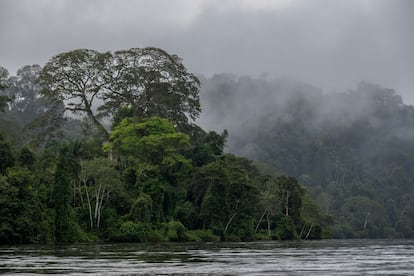
They want the reserve to be given greater protection by law, so that not even the locals who currently use it sustainably — extracting chestnuts or other fruits — are able to enter. The goal is to prohibit all humans except for scientific expeditions. The purpose of Santos’ expedition was to gather information on the flora and fauna in the giant tree sanctuary in order to highlight why the reserve needs better legal protections at the public hearings on the issue, which will take place in Monte Dourado, the municipality where the reserve is located.
Sign up for our weekly newsletter to get more English-language news coverage from EL PAÍS USA Edition
Tu suscripción se está usando en otro dispositivo
¿Quieres añadir otro usuario a tu suscripción?
Si continúas leyendo en este dispositivo, no se podrá leer en el otro.
FlechaTu suscripción se está usando en otro dispositivo y solo puedes acceder a EL PAÍS desde un dispositivo a la vez.
Si quieres compartir tu cuenta, cambia tu suscripción a la modalidad Premium, así podrás añadir otro usuario. Cada uno accederá con su propia cuenta de email, lo que os permitirá personalizar vuestra experiencia en EL PAÍS.
¿Tienes una suscripción de empresa? Accede aquí para contratar más cuentas.
En el caso de no saber quién está usando tu cuenta, te recomendamos cambiar tu contraseña aquí.
Si decides continuar compartiendo tu cuenta, este mensaje se mostrará en tu dispositivo y en el de la otra persona que está usando tu cuenta de forma indefinida, afectando a tu experiencia de lectura. Puedes consultar aquí los términos y condiciones de la suscripción digital.
More information
Archived In
Últimas noticias
Christmas Eve for Christians in Gaza: Confinement, no toys, and explosions near the church
AfD, a key pawn for Trump in Europe, strengthens ties with Washington
From cook to sniper: Ukrainian women fight for equality in the army
Trump succeeds in increasing deportations by hiring military personnel to act as judges
Most viewed
- Christian Louboutin: ‘Young people don’t want to be like their parents. And if their parents wear sneakers, they’re going to look for something else’
- Cartels in Mexico take a leap forward with narco-drones: ‘It is criminal groups that are leading the innovation race’
- ‘El Limones’ and the growing union disguise of Mexican organized crime
- Liset Menéndez de la Prida, neuroscientist: ‘It’s not normal to constantly seek pleasure; it’s important to be bored, to be calm’
- The low-cost creative revolution: How technology is making art accessible to everyone
